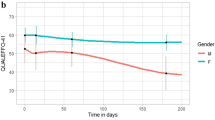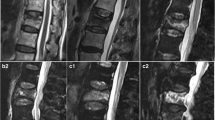Abstract
Purpose
No study has investigated the clinical and radiographic risk factors for the deterioration of quality of life (QOL) beyond 6 months after osteoporotic vertebral fractures (OVF). The purpose of this study was to identify the predictors associated with poor QOL improvement after OVF.
Methods
This post hoc analysis included 166 women aged 65–85 years with acute 1-level OVFs. For the patient-reported outcome measures, scores on the European Quality of Life-5 Dimensions (EQ-5D) scale, and visual analogue scale (VAS) for low back pain were used. Lateral radiography at 0, 12, and 48 weeks and magnetic resonance imaging (MRI) at enrollment and at 48 weeks were performed. The associations between baseline variables with change scores for EQ-5D were investigated using a multiple linear regression model.
Results
Univariate analysis showed that time since fracture, EQ-5D score, and VAS for low back pain at 0 week showed significant association with increased EQ-5D score from 0 to 48 weeks. According to the multiple regression analysis, the following equation was obtained: increased EQ-5D score from 0 to 48 weeks = 1.305 – 0.978 × EQ-5D at 0 week – 0.021 × VAS for low back pain at 0 week – 0.006 × age + (fluid-intensity T2-weighted MR image patterns: − 0.037, except for fluid-intensity T2-weighted MR image patterns: + 0.037).
Conclusion
In conclusion, older patients with severe low back pain and fluid-intensity T2-weighted MR image patterns were more likely to have lower QOL improvements after OVFs and may therefore need extra support to improve QOL


Similar content being viewed by others
References
Rostom, S., Allali, F., Bennani, L., Abouqal, R., & Hajjaj-Hassouni, N. (2012). The prevalence of vertebral fractures and health-related quality of life in postmenopausal women. Rheumatology International, 32(4), 971–980.
Inose, H., Kato, T., Ichimura, S., Nakamura, H., Hoshino, M., Togawa, D., et al. (2020). Risk factors of nonunion after acute osteoporotic vertebral fractures: A prospective multicenter cohort study. Spine (Phila Pa 1976), 45, 895.
Haczynski, J., & Jakimiuk, A. (2001). Vertebral fractures: a hidden problem of osteoporosis. Medical Science Monitor, 7(5), 1108–1117.
Hall, S. E., Criddle, R. A., Comito, T. L., & Prince, R. L. (1999). A case-control study of quality of life and functional impairment in women with long-standing vertebral osteoporotic fracture. Osteoporosis International, 9(6), 508–515.
Paier, G. S. (1996). Specter of the crone: The experience of vertebral fracture. ANS Advances in Nursing Science, 18(3), 27–36.
Suzuki, N., Ogikubo, O., & Hansson, T. (2008). The course of the acute vertebral body fragility fracture: Its effect on pain, disability and quality of life during 12 months. European Spine Journal, 17(10), 1380–1390.
Kato, T., Inose, H., Ichimura, S., Tokuhashi, Y., Nakamura, H., Hoshino, M., et al. (2019). Comparison of rigid and soft-brace treatments for acute osteoporotic vertebral compression fracture: A prospective, randomized, Multicenter Study. J Clin Med, 8(2), 198.
Group TE. (1990). EuroQol–a new facility for the measurement of health-related quality of life. Health Policy, 16(3), 199–208.
McCormack, H. M., Horne, D. J., & Sheather, S. (1988). Clinical applications of visual analogue scales: A critical review. Psychological Medicine, 18(4), 1007–1019.
Keynan, O., Fisher, C. G., Vaccaro, A., Fehlings, M. G., Oner, F. C., Dietz, J., et al. (2006). Radiographic measurement parameters in thoracolumbar fractures: A systematic review and consensus statement of the spine trauma study group. Spine (Phila Pa 1976), 31(5), E156–E165.
Tsujio, T., Nakamura, H., Terai, H., Hoshino, M., Namikawa, T., Matsumura, A., et al. (2011). Characteristic radiographic or magnetic resonance images of fresh osteoporotic vertebral fractures predicting potential risk for nonunion: A prospective multicenter study. Spine (Phila Pa 1976), 36(15), 1229–1235.
Inose, H., Kato, T., Ichimura, S., Nakamura, H., Hoshino, M., Togawa, D., et al. (2020). Predictors of residual low back pain after acute osteoporotic compression fracture. Journal of Orthopaedic Science., S0949–2658(20), 30135–4.
Bursac, Z., Gauss, C. H., Williams, D. K., & Hosmer, D. W. (2008). Purposeful selection of variables in logistic regression. Source Code for Biology and Medicine, 3, 17–17.
Kasl, S. V., & Jones, B. A. (2003). An epidemiological perspective on research design, measurement, and surveillance strategies. Handbook of occupational health psychology (pp. 379–398). Washington: American Psychological Association.
Team RC. (2013). R: A language and environment for statistical computing. Vienna: R Foundation for Statistical Computing.
Kanda, Y. (2013). Investigation of the freely available easy-to-use software 'EZR' for medical statistics. Bone Marrow Transplantation, 48(3), 452–458.
Pfeifer, M., Kohlwey, L., Begerow, B., & Minne, H. W. (2011). Effects of two newly developed spinal orthoses on trunk muscle strength, posture, and quality-of-life in women with postmenopausal osteoporosis: A randomized trial. American Journal of Physical Medicine and Rehabilitation, 90(10), 805–815.
Firanescu, C. E., de Vries, J., Lodder, P., Venmans, A., Schoemaker, M. C., Smeets, A. J., et al. (2018). Vertebroplasty versus sham procedure for painful acute osteoporotic vertebral compression fractures (VERTOS IV): randomised sham controlled clinical trial. BMJ, 9(361), k1551.
Hoshino, M., Takahashi, S., Yasuda, H., Terai, H., Watanabe, K., Hayashi, K., et al. (2019). Balloon kyphoplasty versus conservative treatment for acute osteoporotic vertebral fractures with poor prognostic factors: propensity score matched analysis using data from two prospective multicenter studies. Spine (Phila Pa 1976), 44(2), 110–117.
Albayrak, I., Aydogmus, M., Ozerbil, O. M., & Levendoglu, F. (2016). The association between bone mineral density, quality of life, quality of sleep and fatigue. Acta Clinica Belgica, 71(2), 92–98.
Funding
This work was supported by Grants-in-Aid from the Japan Agency for Medical Research and Development (Grant Number 16dk0110008h0003, to AO).
Author information
Authors and Affiliations
Contributions
HI, TK, HN, MH, DT, ToH, YT, TO, HH, TT, KS, YS, MT, KO, SM, KT, MY, TaH, TY, and AO (1) provided substantial contributions to the conception or design of the study or the acquisition, analysis, or interpretation of data; (2) drafted the paper or revised it critically for important intellectual content; (3) provided final approval of the version to be published; and (4) agreed to be accountable for all aspects of the work in ensuring that questions related to the accuracy or integrity of any part of the work are appropriately investigated and resolved.
Corresponding author
Ethics declarations
Conflict of interest
Hiroyuki Inose, Tsuyoshi Kato, Hiroaki Nakamura, Masatoshi Hoshino, Daisuke Togawa, Toru Hirano, Yasuaki Tokuhashi, Tetsuro Ohba, Hirotaka Haro, Takashi Tsuji, Kimiaki Sato, Yutaka Sasao, Masahiko Takahata, Koji Otani, Suketaka Momoshima, Kunihiko Takahashi, Masato Yuasa, Takashi Hirai, Toshitaka Yoshii, and Atsushi Okawa declare that they have no conflict of interest.
Ethical approval
All procedures performed in studies involving human participants were in accordance with the ethical standards of the institutional and/or national research committee and with the 1964 Helsinki declaration and its later amendments or comparable ethical standards.
Consent to participate
Informed consent was obtained from all participants included in the study.
Consent for publication
Written informed consent was obtained from the patients for publication.
Additional information
Publisher's Note
Springer Nature remains neutral with regard to jurisdictional claims in published maps and institutional affiliations.
Rights and permissions
About this article
Cite this article
Inose, H., Kato, T., Nakamura, H. et al. Predictors for quality of life improvement after acute osteoporotic vertebral fracture: results of post hoc analysis of a prospective randomized study. Qual Life Res 30, 129–135 (2021). https://doi.org/10.1007/s11136-020-02629-9
Accepted:
Published:
Issue Date:
DOI: https://doi.org/10.1007/s11136-020-02629-9




